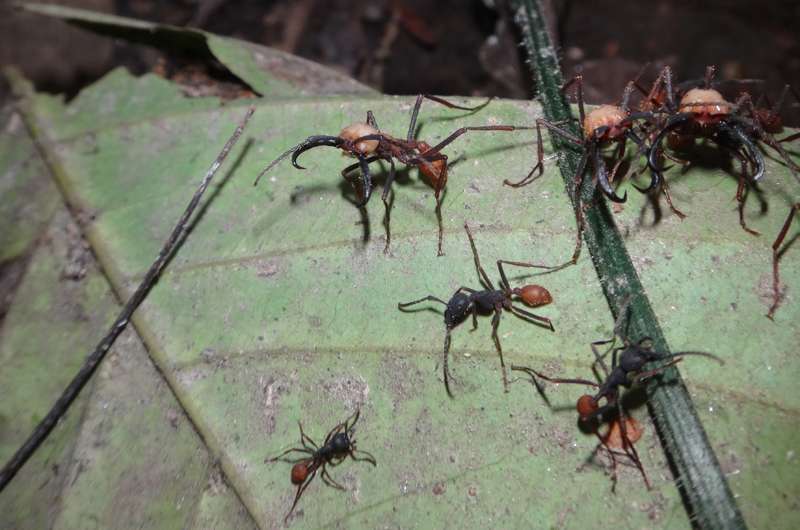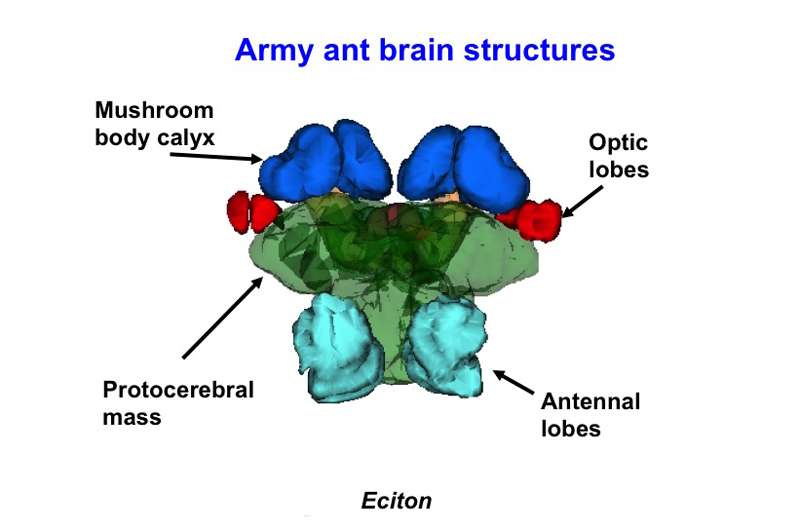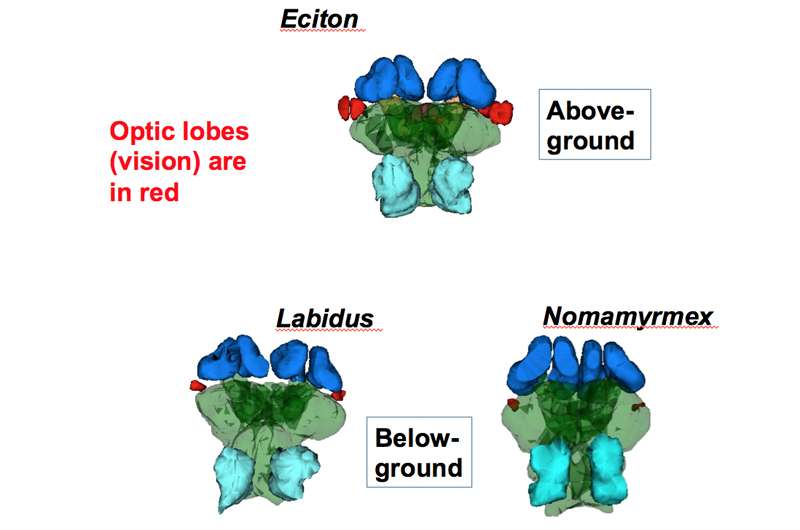Seeing the light: Army ants evolve to regain sight and more in return to surface

A change to a more challenging environment could, over time, re-ignite and grow old parts of the brain that have gone inactive, according to a study of army ants led by a Drexel biology professor.
Sean O'Donnell, PhD, professor in the College of Arts and Sciences, studied several genera (groups of related species) of tropical army ants whose ancestors moved to living mostly underground almost 80 million years ago. The army ant species that continued to live underground appeared to have lost most, if not all, of their vision, but the genus Eciton appeared to gain back sight after returning to live on the surface about 18 million years ago.
"Most of the known examples of changes in brain investment involve shifts to simpler or 'reduced' environments," O'Donnell said. "Classic examples are cases of light-living surface species giving rise to dark-living cave-dwellers. These are frequently—almost always—associated with reduced vision-processing brain regions."
But some of the ants that O'Donnell and his research partners studied appeared to grow back parts of the brain used in seeing. It appeared to be a rare example of a species' brain tissue increasing over time following a move to a more complex environment.

"Our data on visual investment suggest there is at least some room to regain or increase lost sensory and cognitive function," O'Donnell said. "We don't yet know how well Eciton can see and how their eyes work. We found anatomical suggestions that their eye structure is distinct from most other above-ground insects. Have Eciton reinvented the eye to some extent?"
O'Donnell, along with four co-authors, recently published their findings in "Into the black, and back: The ecology of brain investment in Neotropical army ants" in The Science of Nature.
In their study, the Drexel researchers found that the ants that lived mostly on the surface—Eciton hamatum, Eciton mexicanum and Eciton burchellii parvispinum—had significantly larger optical lobes, which are parts of the brain used in sight. Species in other genera that live mainly underground, like Nomamyrmex and Cheliomyrmex, had much smaller optical lobes.
But other brain regions suggested that evolution of vision does not tell the whole story.

In addition to larger optic lobes, Eciton had the largest brain regions used in smell, and the largest brain size overall. In contrast, the mushroom body calyces—parts of the brain that are involved in memory and sensory integration—were found to be the smallest in Nomamyrmex and Cheliomyrmex, the most subterranean of the species the researchers studied.
Together these patterns pointed to light not being the only factor dictating larger brains in surface-dwellers.
"For me, the most exciting and novel patterns are those suggesting the below-ground world is not just different, such as emphasizing olfaction over vision," O'Donnell said. "The data suggest the underground is a simpler world, one that is less cognitively challenging, overall, than the above-ground world. The challenge now is to figure out what about the above-ground environment selects for increased brain investment."
In their paper, O'Donnell and the co-authors suggested a few aspects of the above-ground world that are more complex and require the evolution extra brain space: a diversity in prey, the presence of predators and the variation between day and night-time activities.
"In the case of army ants, we know almost nothing about what behavioral and cognitive abilities are affected by increased brain region size, but our data suggest the army ants are an interesting group to explore these questions," O'Donnell said.
Having more brain tissue (also described as brain investment) is—genetically speaking —an "expensive" evolutionary trait. Brain tissue requires a lot of energy to build and maintain through the consumption of food. So a species won't last long unless there is a good reason to carry that extra brain capacity.
"This study shows that brains closely track animal species' ecology, and that brain evolution can respond to new ecological challenges even after tens of millions of years," O'Donnell said.
More information: S. Bulova et al. Into the black and back: the ecology of brain investment in Neotropical army ants (Formicidae: Dorylinae), The Science of Nature (2016). DOI: 10.1007/s00114-016-1353-4
Provided by Drexel University





















